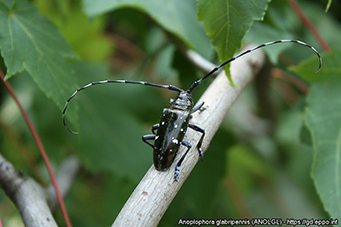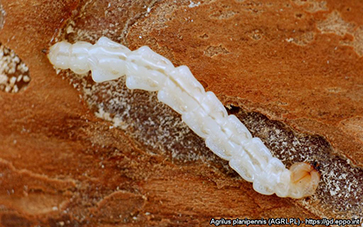
26th Meeting of Panel on Quarantine Pests for Forestry
Teleconference, 2021-04-13/15
The EPPO Panel on Quarantine Pests for Forestry met by teleconference. Situations in EPPO countries in forest quarantine and protection were considered in detail. A special issue of concern was dieback of common aspen (Populus tremula) in Norway and other Nordic countries. For the moment, only Fusarium spp., Septotinia populiperda and Cytospora leucostoma were isolated from aspen but testing will continue in summer 2021. Corythucha arcuata, Anoplophora glabripennis and Agrilus planipennis (the latter of which spread to Ukraine in 2020) remain of major concern for EPPO countries.

Corythucha arcuata – Courtesy: Iris Bernardinelli

Anoplophora glabripennis – Courtesy: Matteo Maspero

Agrilus planipennis – Courtesy: Eduard Jendek
The Panel discussed the phytosanitary treatment ‘Ionising radiation’ described in the EPPO Standard 10/8 ![]() Disinfestation of wood with ionizing radiation. The Panel noted that this treatment is used in several countries and concluded that the EPPO Standard is still valid, and the treatment could be included as an option in the EPPO forestry Standards in the series PM 8 Commodity-specific phytosanitary measures.
Disinfestation of wood with ionizing radiation. The Panel noted that this treatment is used in several countries and concluded that the EPPO Standard is still valid, and the treatment could be included as an option in the EPPO forestry Standards in the series PM 8 Commodity-specific phytosanitary measures.
The Panel considered whether the treatment ‘Kiln drying’ of wood commodities could be used for phytosanitary purposes to prevent (re)infestation of harvested trees and wood commodities. Although kiln drying is an industrial quality treatment done to reduce intracellular moisture of wood (usually to below 20%), the Panel concluded that kiln drying could be included as an alternative option for protection during storage and transport in the EPPO forestry standards of the series PM 8 Commodity-specific phytosanitary measures.
The Panel discussed the phytosanitary treatment ‘Heat treatment’ described in the EPPO Standard 10/6 ![]() Heat treatment of wood to control insects and wood-borne nematodes. The Panel noted that the EPPO Standard is still valid and heat treatment could be included as an option in the EPPO forestry standards of the series PM 8 Commodity-specific phytosanitary measures. The Panel noted that the EPPO Standard 10/6 covers only round wood and sawn wood. Therefore, it could be referenced only for heat treatment of these commodities unless the PRA concludes that a different time/temperature schedule for the pest concerned. For other wood commodities, the option ‘Appropriate heat treatment’ could be used.
Heat treatment of wood to control insects and wood-borne nematodes. The Panel noted that the EPPO Standard is still valid and heat treatment could be included as an option in the EPPO forestry standards of the series PM 8 Commodity-specific phytosanitary measures. The Panel noted that the EPPO Standard 10/6 covers only round wood and sawn wood. Therefore, it could be referenced only for heat treatment of these commodities unless the PRA concludes that a different time/temperature schedule for the pest concerned. For other wood commodities, the option ‘Appropriate heat treatment’ could be used.
The Panel considered the principles of the revision of the EPPO forestry standards of the series PM 8 Commodity-specific phytosanitary measures to ensure consistency between these Standards and the EPPO PRAs. The Panel applied general and specific principles to draft PM 8 Standards for Acer, Platanus & Tilia. The Panel discussed cases when PM 8 Standards cannot be aligned with EPPO PRAs and have developed rational for these deviations. EPPO will then consider whether these PRAs need revision. If differences continue to exist between PRAs and PM8 Standards, a document with these differences and the rational will be published on the EPPO website, and each PM 8 Standard should make reference to corresponding articles of this document for corresponding cases of non-consistency with PRAs. The Panel also decided that guidelines should be developed for the EPPO EWG conducting PRAs for forestry pests.
The Panel considered pests of forestry concern in the updated EPPO Alert List and provided recommendations on them. No deletions from the Alert List were recommended. Four pests were selected as possible candidates for PRA: Lambdina fiscellaria, Neodiprion abietis, Neonectria neomacrospora and Raffaelea lauricola. The Panel proposed to conduct a PRA for Neodiprion abietis and Lambdina fiscellaria but to wait for the Irish PRA for the latter. The Panel did not recommend inclusion of new species of forest pests into the EPPO Alert List.
